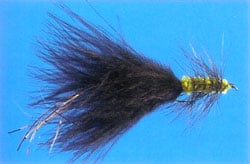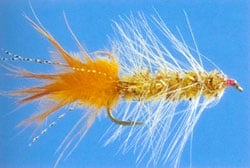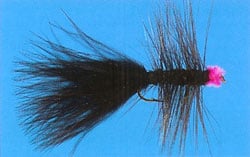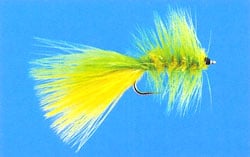Fishing Woolly Buggers

Black Woolly Bugger
RUSSELL BLESSING, who invented the pattern, says he usually starts out dead-drifting the Bugger, “to see what happens.” If that doesn’t produce, he will add jigging motions on the strip, jig it back at the end of the drift as Barry Beck described [see several paragraphs below], cast up and across the current and let it swing, use hand-strip retrieves. “Sometimes,” he says, “it takes fast strips. Some of the guys around here will strip it as fast as they can. Almost everything works, some of the time.” Amen to that.
Al Rockwood, the Michigan steelhead guru and steelhead fly tier, says, “In my opinion, the Woolly Bugger is the most effective wet fly for trout in Michigan. It works for steelhead and salmon in bigger sizes. I have found it deadly for brookies in Labrador, steelhead in Michigan, and browns in New Zealand. Dead-drifted or stripped, down deep or on the surface, the Woolly Bugger is a sure attractor pattern.” California’s Ralph Cutter has written, “The Woolly Bugger is an intern’s fly: It can’t be fished wrong.” The Lake Taneycomo guide Brian Schaffer, of Branson, Missouri, calls the Bugger the “Fly of the Century.” He says he does 90 percent of his night fishing with a black Woolly Bugger (often tied with fluorescent lime green thread and three strands of Krystal Flash added to the tail), working his way to lighter colors as necessary. “The best thing about having a Woolly tied to your leader,” he says, “is you almost can’t fish it wrong.”
Although the Woolly Bugger can be fished anywhere in the water column, it probably is more often fished close to or down on the bottom. That’s why most people tie them weighted. How much you weight a fly determines how quickly it will sink and how well it will stay down in a current. The aforementioned Brian Schaffer ties them both ways, in sizes 4 to 12, using 10 to 24 wraps of 0.10- to 0.30-inch-diameter lead wire on his weighted Woollies.
Where you place the weight affects the way it will swim. Lead wire that’s centered on the shank creates a Woolly Bugger that’s better for bottom-bouncing than for swimming higher in the water column; it just won’t produce an enticing action when twitched or stripped in midwater. Slide those wire wraps forward or backward along the shank, and the Bugger fishes altogether differently. Mount a split shot, a bead, or a cone head at the front of the shank, and your Woolly Bugger will have a rising-diving, yo-yo action on a stop-and-go retrieve.
Unweighted Woolly Buggers have, I believe, a more seductively sinuous action than heavily weighted ones. The problem is getting them down where the fish are. If you want a yo-yo action, crimp a split shot onto the tippet immediately ahead of the fly. If you prefer a fly that will respond better to your manipulations of the line and rod, crimp the shot farther up the tippet, or use a sinking leader, a sinking-tip line, or a fullsinking line. Weighted leaders and crimped shot will keep a sunken fly swimming closer to the bottom than either a sinking or sinking-tip line. It’s a simple matter of geometry: When the line is weighted, you will be pulling it toward you, off the bottom. Keeping the weight closer to the fly (in or on the leader or the fly itself) keeps it deeper, longer. Sinking-tip lines offer a compromise.

Chili Pepper
You can dead-drift, swing, bottom-bounce, crawl, or faststrip a Woolly Bugger. Given the right time and place, each of those techniques will take fish. If one doesn’t work, try another. Or combine two or more on the same retrieve. Barry Beck, writing in The Fly Fisherman, said, “[T]he most productive technique is to pump [the Woolly Bugger] back with a slow, patient retrieve.” (The retrieve is preceded by pinching a B or BB shot immediately ahead of the fly and casting it up and across the current.) He defined the winning retrieve as a combination of 3- to 5-inch, hand-over-hand strips accompanied by a 4- to 5-inch, up-and-down rod motion. That combination gives the Bugger’s marabou tail the proper “breathing” action that turns fish on.
For trout, Barry Beck likes to fish Woolly Buggers in lowlight times of day — the first two or three and the last two hours of daylight — or at night. For bass, he concentrates on deep channels and runs during the afternoon and on the flats and shore areas and the edges of lilypad beds early in the morning and as night approaches. For bluegills and crappies, Beck likes an allwhite Bugger. For pike and pickerel, he fishes yellow or red-andyellow Buggers over weedbeds with a fast, hand-strip retrieve. Whether you weight your Woolly Buggers or not, you can fish them as baitfish, as leeches, hellgrammites, aquatic worms, nymphs, crayfish, or who-knows-what-else.
Fishing Woolly Buggers to Imitate Different Fish Foods
Although a Woolly Bugger will probably catch fish no matter how you fish it, you can move the odds in your favor by fishing it to resemble whatever forage species may be about.
Baitfish
Think of the Woolly Bugger as a streamer. Use a stop-and-go retrieve to give the Bugger the darting motion of a nervous baitfish. From time to time, insert a long, fast strip into the retrieve, as if the baitfish had spotted a predator and decided to scram. Twitching an unweighted Bugger just below the surface sometimes makes fish mistake it for a wounded minnow. To imitate darters, keep the fly on the bottom and use fast, short strips. Sculpins swim a bit more deliberately, so you can also fish the Bugger along the bottom a bit more slowly. If the stream you are fishing has both darters and sculpins, fish your bugger like a sculpin: They’re slower and easier to catch, and fatter besides, and predatory fish have figured that out.

Egg Sucking Leech
Leeches
To imitate leeches, your fly must be long and supple and swim with vertical undulations. In midwater, leeches don’t swim as much as they writhe and struggle while the current carries them along. When leeches are hugging the bottom or being bruited about in fast water, they aren’t nearly so long and thin and supple. However you fish your Woolly Buggers, they might be taken for leeches. Then again, they might be taken for something else. You never know.
Nymphs
Although most anglers think of the Woolly Bugger as a general-purpose streamer or leech imitation, Russell Blessing had the hellgrammite in mind and he ties them short and small to imitate caddis and fishfly larvae. In different sizes and colors, the Bugger probably also passably imitates or strongly suggests the nymphal forms of dragonflies, damselflies, craneflies, stoneflies, and the larger mayflies. Fish a Woolly Bugger the way you would any other nymph: deaddrift, in Leisenring lifts, or twitched along the bottom. Or high-stick an upstream nymph presentation (what Brits call long-tumble nymphing).
Minnesotan Reed Munson usually fishes his Buggers where runs or riffles tail out into pools, casting across the stream and letting the current drift the fly down into the head of the pool. But if the water is low or very clear, he says, “most likely the trout will see you.” That’s when he switches to upstream nymphing techniques. “You can sneak up on the fish with less likelihood of being seen,” he says. “Look for a good run. I like heads of pools, large submerged rocks, or undercut banks. Cast the Woolly Bugger upstream of the fishy-looking spot. Watch the strike indicator. Hopefully, as the Bugger passes the likely-looking area, you’ll see your indicator jump.”
Crayfish
I am convinced that trout, bass, and panfish often take the Woolly Bugger for a fleeing crayfish. When I want to present a crayfish imitation, I will often fish a Bugger or some variation thereof. Many so-called crayfish patterns are designed to look more like crayfish in the vise than in the water, are a bear to cast, and often twist the leader. The few patterns that don’t suffer from these afflictions — the Clouser Crayfish being a notable exception — are a lot more difficult or time-consuming to tie than Woolly Buggers. (My love of fishing Clouser Crayfish is offset by my fear of losing the expensive-to-buy and tedious-to-tie critters, which too often keeps them in the safety of my flybox.)
Many fly fishers use medium-length, medium-speed strip retrieves to fish crayfish patterns. It works, but it doesn’t mimic the way crayfish move. When crayfish aren’t being threatened, they crawl along very slowly. When threatened, they may rapidly scoot several yards at a clip. So don’t be afraid to mix in both slow, steady, hand-twist retrieves and long, fast strips.

Salty Bugger
Saltwater Prey
In salt water — from which leeches, hellgrammites, and crayfish are absent — anglers often fish their Woolly Buggers in midwater and near the surface. Salty Buggers tend to be gaudier than freshwater Buggers (steelhead and Pacific-salmon Buggers excepted), as well as bigger. What do saltwater fish take them for? I don’t know — lighted-up squid? Tropical reef fish? Royal Wulffs? But they sure do take them. A long-tailed, silverygreen Bugger, tied on a 6X-long hook and stripped fast, can probably pass for a needlefish or sand eel in salt water. In Fly Fishing for Bonefish(1993), Dick Brown writes of the Woolly Bugger, “This ubiquitous freshwater pattern, in its original olive and black colors, is a good goby imitation for shoreline and tidepool areas. In tan or flesh colors, it is also effective as a polychaete worm pattern.” (Later in the book he clarifies the polychaete pattern as having an “orange or flesh-colored body and white marabou and saddle hackle….”)
Although I haven’t fully field-tested it, a large, pale tan or gray Bugger with short or clipped hackle just might pass muster as a squid. Denmark’s Martin Joergensen, who probably knows as much about taking sea-run brown trout in salt water as any man alive, has written (in Saltwater Flyfishing – Britain & Northern Europe by Paul Morgan and Friends, 1998), “If you have the choice of one single fly, choose a black or grey Woolly Bugger, size 6. This fly represents the stem of many of the most successful flies for sea trout in salt water.” This, from a man who has designed many of the best-known and most successful flies used to fish for brown trout in the Baltic Sea.
No matter how or where you fish your Woolly Buggers, don’t be in a hurry to snatch the fly out of the water for another cast. Because of the way marabou “breathes” in water (even — no, especially — when the fly is motionless in the slightest bit of current), you should always give the tail a chance to do its thing. Lift the fly in the water column, then let it fall slowly without any input from you. Let it dangle in the current at the end of a drift or retrieve for a few moments, enticing a following fish to grab it before it gets away.
You won’t live long enough to experiment with all the different ways Woolly Buggers can be fished, to take advantage of the myriad variations in materials and tying methodologies currently in use on waters and vises around the world. It’s hard to go wrong, fishing Woolly Buggers. Whenever the fishing slows down, try them even when experience dictates that you fish a wildly different fly.
Mark R. Tompkins, of Sacramento, California, related an eye-opening home-water experience while photographing for this book. In describing three of the photos, he wrote:
“The rainbow in the slides was one of the most beautiful I have ever caught. And he was one of the strongest, too. He jumped at least half a dozen times before I could bring him in. And I don’t think I would have caught him if it weren’t for you. You see, I normally fish two tiny caddis nymphs in the Calaveras River. But I decided to give one of my dumbbelleyed Olive Woolly Buggers a try. On the first cast, my line went tight. You just never know!”
I can’t promise you a trophy rainbow on your first cast with a Woolly Bugger, but I can safely promise you will over time catch a variety of fish under a variety of conditions, often when nothing else is working.











